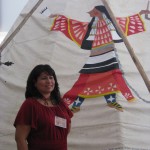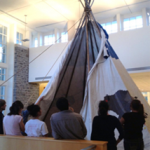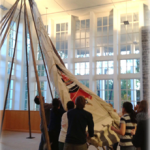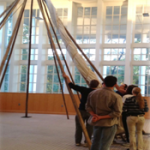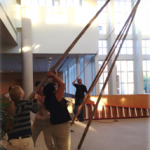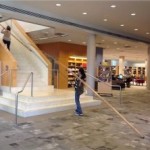Attendee Reflections
“A Reflection on Visiting the Carlisle Indian School“

Warren Petoskey, Little Bay Bands of Odawa Indians
…I have mulled over what I might write and pass on regarding what we saw, experienced and understood during our visit. We heard powerful Native and non-native speakers talk about the history of Carlisle and its impact on Native children. The data we saw said that over 10,000 children passed through that school in the nearly forty years it was open. We also saw that the two tribes with the largest number of children who attended Carlisle was the Sioux with over a thousand of their children attending and the Chippewa with 998 children who attended.My grandfather and his sister, my great aunt attended. My grandfather graduated in 1902. It is our belief that when my grandfather’s dad walked on, his two children were taken to Carlisle. Our lives as a family would never be ordinary or normal due to the psychological effects my grandfather displayed. Not only was he dealing with all the conditions brought on our people by the foreign occupation and take-over, in addition, he had to try to process what he was forced to go through at the military style boarding school and the abuse he experienced.
Due to the behaviors of my grandfather, he and my father had no relationship at all. It is not important why. I used to think it was, but when Carlisle came into the picture and after hearing all the stories from the elders who experienced Carlisle I knew why my grandfather was the way he was.
My grandfather walked on when I was three. They tell me he would come to visit when I was born and wanted to hold me and be a grandfather to me, as much as he knew how, but that was limited because he was raised in an institution with no parents or elders around him to teach him or be examples… [H]e appeared suspended between two worlds, one his Native origin, and the other the false world that was taught him.
So, what is to be done? I believe the First Nations and Metis of Canada have already laid the ground work for the work that needs to be advanced in the United States. Healing, reparation and reconciliation needs to take place. Crimes committed need to be made public. The actual number of children who died in the boarding schools need to be published. Apologies need to be made and religious and political institutions held morally and legally accountable. For the entire article published in Native News Network, go here.
Joy’s Reflection
I’ve been doing this work for five years… I also work with the living survivors of the mush hole and the salum. On Day Two of the conference I woke up around 5am and I had been crying in my sleep… but then when I was at the conference itself many amazing things occurred, and many amazing people spoke of their experiences. I believe I can safely say that many of us found healing there at Carlisle this weekend, while we struggle to find the words to tell the students’ stories. And Maurice Kenny read us one of his poems and had us in stitches, before, during and after his presentation. Two amazing women gave me strength through their convictions. I’ve never seen such activism! It was a good time for us all.
Excerpt from Professor Gurel’s Reflection
I have been meaning to write you and let you know what a big impact last week’s conference had on me and everyone else. It was simply the best conference I have observed — the stakes were clear throughout; the speakers were excellent; I didn’t look at my watch once. It is making me re-think my plans for my second book and how I have been teaching my flagship course, Transnational America.
Committee Reflections
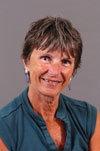
Sharon O’Brien
Professor of American Studies
This was the most extraordinary symposium I’ve ever attended. Because of the non-academic, native structure and sessions, mingling stories with poems with videos with papers with the most heart-felt audience response I’ve ever seen, this symposium engaged us all as whole people: mind, heart, and spirit. Several attendees and participants spoke of “healing” as a process that took place during it, and I think that process was connected with the creation of a safe and native “space” that was both physical (ATS and the Dickinson campus) and emotional. Given that we were dealing with the traumas inflicted by another school and another space in Carlisle – the Indian School – the fact that healing could be linked with Carlisle and an academic institution had a kind of circular karma to it that itself could be part of Indian story telling. The conference felt like a return, but also like a new beginning.
The question for me was: how could there be an “ending” to this extraordinary conference? Would there be conflict? Separation? Decisions on future activism? Unity? And given all that had gone on, how could we feel that we had come to a resting place so that we could leave with a sense of completion? We were fortunate beyond words in having N. Scott Momaday end the conference with his spiritually-grounded gravity and wisdom. What he did was both extraordinary and right. He reminded us that those who suffered were children and so brought us back to the reality of the Indian school, and to Native American history and loss. He then described the important day he had had, visiting the battlefield at Gettysburg and thinking about Lincoln’s Gettysburg Address. He illuminated for me the importance of the Carlisle Indian School to Native American history by saying that its name and history should be as prominent as Wounded Knee and Little Big Horn. And by juxtaposing the Indian School to Gettysburg, he placed what happened at Carlisle in American history more broadly: this is a story about all of us. And it should be told. Lincoln was honoring the dead in his Gettysburg Address, and so should we honor these children, and their descendants, as we make the Carlisle Indian School part of our history. Every Dickinson student needs to know about the Indian School, I thought; somehow, somewhere, this needs to be part of a common curriculum.
When Momaday finished his remarks and the applause died down, everyone was silent and still. You could have heard a pin drop in ATS. No one was going anywhere. Momaday had returned us to the sacred space Jemison had created at the beginning and had elevated and deepened our symposium by giving us a mission: make the story of this school part of American history, let its name be known. Given that the Indian children lost their native names as part of the socialization process, being able to name the school, and name what happened there, could also be a kind of circular process that can lead to healing and reconciliation. But only if the truth is told and listened to, as it was that weekend.

Arriving at the Lakota Dinner
I felt changed by that weekend; I now feel attached to this symposium and its future in a profound way. I have joined something. I was part of something for two days, and I want to stay connected to what happened since the conference released living energies that are going to lead somewhere.
Excerpt from Jacqueline Fear-Segal’s Reflection
I am still living in the afterglow of the Symposium. So much happened and was achieved… all the hard work bore such wonderful and varied fruit. I loved hearing the students’ responses, and imagine their time at Dickinson will be quite different from how it might have been, having been introduced to the CIIS in such a big way right at the beginning.
Student Reflections from Professor Rose’s First Year Seminar –
“Site of Memory: Reclaiming Indigenous Histories”
Carolyn Cook-Rittenhouse’s Experience of Reclaiming Lakota Roots
Excerpt from Samantha’s paper, First Year Student
Carolyn enlisted the help of Lakota ledger artist Dwayne Wilox to help draw and paint her canvas. Carolyn chose to depict the” Buffalo Calf Woman Brings Sacred Pipe” because the Buffalo Calf Woman brought the sacred pipe and teachings to the Lakota people during their time of need. She represents this on the tipi with a ledger style painting of the Buffalo Woman wearing a bright red dress holding an eagle feather. The Lakota believe that the Buffalo Calf Woman turned into a buffalo and is a symbol of hope and healing. Carolyn further represented this story by including a painting of a buffalo on her tipi. Next, she chose to represent the Massacre at Wounded Knee of 1890. Carolyn wanted to honor her ancestors who were involved in the massacre, especially the women and children. To honor every Native American at Wounded Knee Carolyn researched the names of Chief Big Foot’s and Chief Bald Head Eagle’s tribe members. After careful planning and painting over three hundred names now wrap around the tipi. Along with the names Carolyn’s parents asked her to include the saying “you will not be forgotten, we will remember you.” To further memorialize Wounded Knee Carolyn painted silhouettes of people on the border of the tipi to commemorate the women and children who were killed at Wounded Knee. Carolyn also included a silhouette of the actual monument that stands next to the gravesite at Wounded Knee.
The top of the tipi is painted sky blue with white stars to honor Carolyn’s relatives who have passed away…The biggest star on the tipi is dedicated to Carolyn’s sister who died at an early age. The last major theme Carolyn chose is The Battle of Little Big Horn of 1876, in honor of her ancestor, Chief Iron Hawk, who fought to save the Native American people during the battle. The Battle of Little Big Horn along with Carolyn’s family history will be depicted on the tipi’s inside liner, which is still a work in progress.
Carolyn’s journey was more than decorating a tipi, it was a way for her family to reclaim their indigenous history. Throughout this process Carolyn learned more about her family than she ever could have expected. As Carolyn gave her presentation about her tipi at the Carlisle Symposium it was easy to see that she is proud and grateful to have gone through this experience and to be able to share it with others. Carolyn finished her presentation by describing the entire experience in four words: “a labor of love.”
Never Go Back Home
Excerpt from Majer’s Reflection, First Year Student from Singapore
Home, a place that is closest to your heart; a place that will help you to shelter all the thunderstorms; a place that you are not afraid to show your weaknesses; a place that you will always go back to. Yet, home is endless waiting. Home is countless miles. Home is forgotten past. They never make it home.
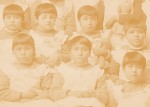
Children at the Carlisle Industrial Indian School
“The Stones at Carlisle” echo the experiences of many Native American children who spent time in the off-reservation boarding schools. Although hundreds of years have passed, these off-reservation schools still have a big impact on the Native Americans. On 5th and 6th of October 2012, people from all over the country came together in the Carlisle, PA: Site of Indigenous Histories, Memories and Reclamations Symposium to reclaim their history and culture and teach us.
Gathering in Carlisle was significant because of the Carlisle Industrial Indian School (CIIS), the off-reservation school model developed by Captain Richard Pratt in the late nineteenth century. Off-reservation schools, according to Pratt, needed to be far away from the Indian reservations in order to cut all cultural ties possible with the tribal societies in order to transform the Indian students into civilized citizens. Over 10,000 Native students attended Carlisle during its forty years of existence. The Native participants of the symposium were either the descendants of Carlisle students or they knew people who have experienced Carlisle. They shared the stories of these students’ boarding school experiences that were too often ignored.
“They are children!” the Pulitzer Prize winner N. Scott Momaday said, “the children, they have no choice and no advantage whatsoever, they are helpless and afraid. They are brought here and in a matter of days, they are shorn of their names, their childhood, their dress, their religion, their language, their identity, their culture! How could they live? How could they live through such experiences?”

Margo Tamez at the Carlisle Symposium
Excerpt from Stephanie’s Reflection, First Year Student from New York
One woman who fully embodies the fighting spirit of a warrior is Margo Tamez who from 2001 to 2005 spent her time in different courts fighting for the rights of the Indigenous people and is presently fighting for her people, the Nde’ on the border of Mexico and the United States. Margo Tamez presented her slide show on four strong Native women: Kesetta, Augustina, Falvia and Eloisa. Tamez’s passionate account of their stories and her own work is what captured my attention the most. Leaning forward she gripped the podium and thrust her hand outwards, pushing for us, the non-Native Americans, to grasp her people’s struggle. In the end, choking back tears filled with passion and fight she simply stated her answer for the reason why she fights so hard for her people. That answer was love.
Excerpt from Katie’s Reflection, First Year Student from Tennessee
The Carlisle Symposium, held October 5 and 6 at Dickinson College, was for many a plethora of bittersweet moments. As my eyes wandered around the room during various presentations, I could see the faces of those tensing to suppress tears and those unable to hold them back anymore. I also discerned a trace of light in the eyes of some as Gregory Younging began to discuss the Truth and Reconciliation Commission. A Professor of community, culture, and global studies at the University of British Colombia, Dr. Younging works as Assistant Director of Research for Canada’s Truth and Reconciliation Commission (TRC) – established in June of 2007. His position entails researching and providing documentation to the Canadian government concerning the treatment of Native Americans at residential schools. He also helps to determine how the government should repay people and steps the country should take to encourage the healing process, thus providing truth and reconciliation- as much as possible considering the circumstances.

 The metaphor storyteller Dovie Thomason used to describe [how to deal with the pain and loss] was “a pile of buffalo shit.” When the shit is fresh, well you just do not want to touch it” she declared to laughter. However, after the sun and weather and time have taken their course, the shit dries and transforms into fuel; that fuel that can be used to provide us with energy- the energy to channel hope for Native Americans and whites alike, as we try to atone for the depravity of our ancestors and seek truth and reconciliation.
The metaphor storyteller Dovie Thomason used to describe [how to deal with the pain and loss] was “a pile of buffalo shit.” When the shit is fresh, well you just do not want to touch it” she declared to laughter. However, after the sun and weather and time have taken their course, the shit dries and transforms into fuel; that fuel that can be used to provide us with energy- the energy to channel hope for Native Americans and whites alike, as we try to atone for the depravity of our ancestors and seek truth and reconciliation.
Today, the TRC [of Canada] seeks to convert that pile of shit into fuel by providing the evidence and informed suggestions needed to repay the Natives of their country. Their goals are to “acknowledge Reservation School experiences, impacts, and consequences, provide a holistic safe setting for former students and their families, witness and report the truth, and support and promote awareness and public education” (Dr. Younging). The TRC cannot stress the importance of increasing public awareness enough; many Canadians still do not realize the atrocities that occurred in their country regarding the “civilizing” of Native Americans. As philosopher Trudy Govier articulates, Canadians “[…] have chosen to ignore many facts, problems, and cries of pain […]. We did not know because we did not want to know. We did not want to know because the truths we would face would be unpleasant and incompatible with our favoured picture of ourselves […];” however, we must begin to change our attitudes and acknowledge the wounds we have inflicted (Regan 45).
As Dr. Younging discussed Canada’s TRC, many in the room felt a glimmer of hope. Some felt that the Commission could serve as the basis for a similar commission in the United States. Canada has started to turn their buffalo shit into fuel. Now it is the United States’ turn.
Excerpt from Zha’s Reflection, First Year Student from Guangzhou, China
At this point, I am in a state of reminiscence, ruminating about the past three days when I was totally immersed in a history brought alive, history that no longer lingers on the pages and between lines of words… I heard the resonant voice of Dovie Thomason, which rendered me a little child, sitting near the glimmering fire listening to a tribal elder telling stories. Dovie said that “history is the life of people.” I saw the pictures Jennifer Nez Denetdale showed, pictures containing the stories of her own great great great grand-father. She sobbed as she said: “These photos show their (her ancestors) courage and will to live. They remind me of the Long Walk… My ancestors carried the burden and moved on…” I also re-heard Laura Tohe’s poems and I marveled at such metaphor: “The Indian School experience is like a sentence; we are all veterans of this institution.” Interestingly, however, this sense of powerlessness is also accompanied by a sense of maternal superiority, as Tohe expressed in her letter to Pratt: “You and your followers are still children. You have not yet learned how to get on with people.”
